Oplismenus undulatifolius
Oplismenus undulatifolius, commonly known as wavyleaf basketgrass, is a species of perennial grass from the family Poaceae that is native to Eurasia, specifically Southern Europe through Southern Asia.[3][4] Due to its invasive nature, it can be found in countries such as Pakistan (Punjab & Kashmir),[2] China, Japan,[5] Korea, India, Australia,[6] South Africa,[2] and has since been introduced to the Mid-Atlantic United States. There are no recognized subspecies in Catalogue of Life.[7]
| Wavyleaf basketgrass | |
|---|---|
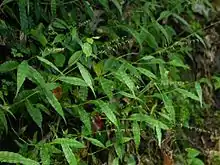 | |
| Scientific classification | |
| Kingdom: | Plantae |
| Clade: | Tracheophytes |
| Clade: | Angiosperms |
| Clade: | Monocots |
| Clade: | Commelinids |
| Order: | Poales |
| Family: | Poaceae |
| Subfamily: | Panicoideae |
| Genus: | Oplismenus |
| Species: | O. undulatifolius |
| Binomial name | |
| Oplismenus undulatifolius | |
| Synonyms[2] | |
| |
Description
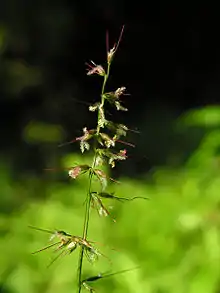
Oplismenus undulatifolius is a shallow rooted perennial with stolons that may grow to several feet in length. The leaves of overwintering plants become brown and dead, but in the spring, new growth begins at the upper nodes of the stolons. In early fall, the sticky awns readily adhere to anything that brushes against them which makes for an effective mode of dispersal.
The species is 15–50 centimetres (5.9–19.7 in) long with leaf-blades being slightly lanceolate, ovate, and are 1–7 centimetres (0.39–2.76 in) long and 4–15 millimetres (0.16–0.59 in) wide. Its inflorescence is 2–8 centimetres (0.79–3.15 in) long and is made out of 5-11 cuneate fascicles which are 0.5–1.5 centimetres (0.20–0.59 in) in length and carry 2-6 spikelets.[8] Spikelets are lanceolate just like leaf-blades, and are 2.5–4 millimetres (0.098–0.157 in) in length. They are also glabrous and pubescent and have glumes which have smooth viscid awns which are 7–14 millimetres (0.28–0.55 in) long.[2] The awns of lower glumes are purple, are 5–10 millimetres (0.20–0.39 in) in length and are 3-5 veined. The lower lemma is herbaceous and have 5-9 veins while the upper one is 5 veined with an awn that is 2–5 millimetres (0.079–0.197 in). The species apex have a stout that is 1–2 millimetres (0.039–0.079 in) long. Flowers and fruits grow from July to November.[5]
This species grows particularly well in moist, shaded environments, in a variety of soil types. In Australia it grows in shady coastal forests at Coffs Harbour.[6]
Ecology
In its native range, Oplismenus undulatifolius is a food source for many species of Lepidoptera, including Elachista kurokoi,[9] Helcystogramma fuscomarginatum,[10] Mycalesis francisca,[11] Mycalesis sangaica,[11] Mycalesis zonata,[12] Palaeonympha opalina,[13] Stigmella oplismeniella,[14] Ypthima akragas,[12][15] Ypthima baldus,[12][15] and Ypthima esakii.[12][15]
As an invasive species
Accidentally introduced into the United States in Maryland and Virginia, this species spreads quickly and is becoming extremely invasive in forested natural areas in the Mid-Atlantic region across numerous counties in Maryland and Virginia.
The species was first reported in Maryland in 1996, growing around the Liberty Reservoir area and the northern section of the Patapsco River in Howard County. The grass spread quickly into connected natural areas in Baltimore and Carroll counties. By 1999 it was identified in Montgomery County at Wheaton Regional Park.[16] In 2006 it was identified in Prince George's County at Little Paint Branch Park , the adjacent Beltsville Agricultural Research Center-East and the National Greenbelt Park. It had crossed into Virginia by 2004 where it was found growing at an 80-acre (320,000 m2) site in Shenandoah National Park, and in a 20–30-acre (81,000–121,000 m2) site at the Fraser Preserve along the Potomac River in Fairfax County.[17]
Once a population has become established, complete eradication from a site has proven to be extremely difficult due to a long-lived perennial life cycle, a long seed germination season (April–November), and considerable seed mobility of the species.[18]
Gallery
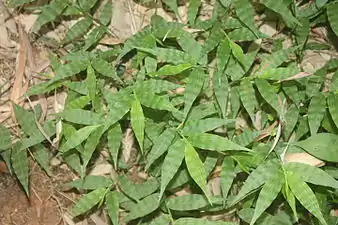
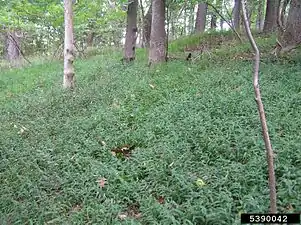 Wavyleaf basketgrass infestation. Habitat: closed-canopy mesic forest in Maryland, United States.
Wavyleaf basketgrass infestation. Habitat: closed-canopy mesic forest in Maryland, United States. Leaves of the perennial wavyleaf basketgrass die off each winter (mid-December shown). Plants will survive cold winters and leaves will re-emerge each spring. Photo shows winter appearance of non-native infestation in Maryland, United States.
Leaves of the perennial wavyleaf basketgrass die off each winter (mid-December shown). Plants will survive cold winters and leaves will re-emerge each spring. Photo shows winter appearance of non-native infestation in Maryland, United States.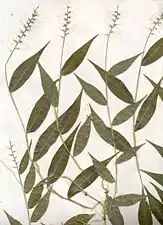 Invasive wavyleaf basketgrasss collected from Liberty Reservoir in Maryland in 1997.
Invasive wavyleaf basketgrasss collected from Liberty Reservoir in Maryland in 1997.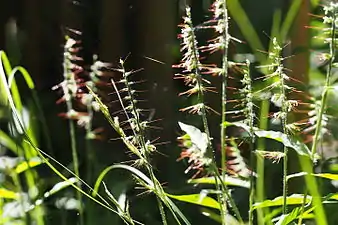 Oplismenus undulatifolius with reddish purple awns and white flowers in Kobe, Japan.
Oplismenus undulatifolius with reddish purple awns and white flowers in Kobe, Japan.
References
- "Oplismenus undulatifolius (Ard.) P. Beauv.". Catalogue of New World Grasses. (CNWG). Missouri Botanical Garden – via Tropicos.org.
- Cope, Thomas A. "Oplismenus undulatifolius". Flora of Pakistan. Retrieved 4 February 2016 – via eFloras.org, Missouri Botanical Garden, St. Louis, MO & Harvard University Herbaria, Cambridge, MA.
- "Wavyleaf Basketgrass (Oplismenus hirtellus ssp. undulatifolius)". www.invasive.org. Retrieved 2020-07-22.
- "Oplismenus hirtellus ssp. undulatifolius/NJ - Bugwoodwiki". wiki.bugwood.org. Retrieved 2020-07-22.
- Chen, Shou-liang; Phillips, Sylvia M. "Oplismenus undulatifolius". Flora of China. 22. Retrieved Nov 20, 2015 – via eFloras.org, Missouri Botanical Garden, St. Louis, MO & Harvard University Herbaria, Cambridge, MA.
- "Oplismenus undulatifolius (Ard.) P.Beauv". PlantNET. Retrieved May 16, 2013.
- "Oplismenus undulatifolius". World Checklist of Selected Plant Families (WCSP). Royal Botanic Gardens, Kew. Retrieved Nov 20, 2015.
- W.D. Clayton; M. Vorontsova; K.T. Harman; H. Williamson. "Oplismenus undulatifolius". The Board of Trustees, Royal Botanic Gardens. Kew: GrassBase. Retrieved May 16, 2013.
- Sugisima, K., 2005: A revision of the Elachista praelineata group (Lepidoptera: Elachistidae) in Japan, with comments on morphology of the pupa in Elachista. Tijdschrift voor Entomologie 148: 1-19. Full article: .
- "Helcystogramma". www.nic.funet.fi. Retrieved 2016-02-10.
- "Mycalesis". www.nic.funet.fi. Retrieved 2016-02-10.
- "HOSTS - The Hostplants and Caterpillars Database at the Natural History Museum". www.nhm.ac.uk. Retrieved 2016-02-10.
- "Palaeonympha". www.nic.funet.fi. Retrieved 2016-02-10.
- Kemperman, Theo C.M.; Wilkinson, Christopher (October 1985). "Japanese Species Of The Genus Stigmella (nepticulidae: Lepidoptera)" (PDF). NEW SERIES 32. 1: 107. Retrieved 10 February 2016. Cite journal requires
|journal=(help) - "Ypthima". www.nic.funet.fi. Retrieved 2016-02-10.
- Peterson, P.M., E.E. Terrell, E.C. Uebel, C.A. Davis, H. Scholz, and R.J. Soreng. 1999. (Scientific Note) Oplismenus hirtellus subspecies undulatifolius, A new record for North America. Castanea 64:201-202.
- Beauchamp, Vanessa B.; Koontz, Stephanie M.; Suss, Christine; Hawkins, Chad; Kyde, Kerrie L.; Schnase, John L. (2013). "An introduction toOplismenus undulatifolius(Ard.) Roem. & Schult. (wavyleaf basketgrass), a recent invader in Mid-Atlantic forest understories1,2". The Journal of the Torrey Botanical Society. 140 (4): 391–413. doi:10.3159/TORREY-D-13-00033.1. ISSN 1095-5674.
External links
| Wikispecies has information related to Oplismenus undulatifolius. |
| Wikimedia Commons has media related to Oplismenus undulatifolius. |
- Oplismenus undulatifolius on YouTube
- Invasive Species of Concern in Maryland. Invader of the month (August 6, 2007); Wavyleaf basketgrass, (Oplismenus hirtellus ssp. undulatifolius).
- Wavyleaf Basketgrass, Wildlife and Heritage Service, Maryland Department of Natural Resources.
- Wavy-leaf Basket grass Eradication at BARC.
- Virginia Forests: Wavyleaf Basket Grass, an Invasive Exotic, Found in Virginia.
- Maryland Chapter of Sierra Club: Wave Goodbye to Wavy Leaf Basketgrass.
- Chesapeake Bay Journal: Wave bye-bye to wavyleaf basketgrass by Karl Blankenship.
- Maryland has become ground zero for a new invasive species threat, wavyleaf basketgrass, by Jill Rosen.
- Flora of the Carolinas, Virginia, Georgia, and surrounding areas by Alan S. Weakley (Page 897).
- Oplismenus undulatifolius in the Guide to Invasive and Hegemonic Grasses